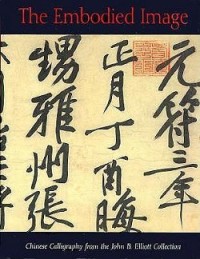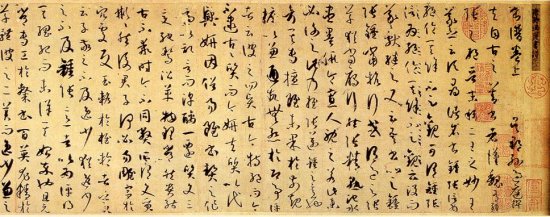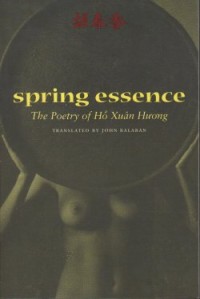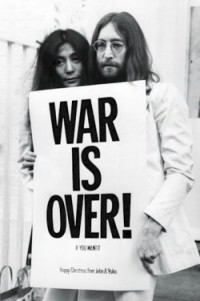On Chinese calligraphy
This week, you can see the most important show of Chinese calligraphy ever mounted in the West; you can buy the first book ever to digitize the old Vietnamese calligraphic system; and you can visit a modern show in which a Japanese artist uses the calligraphic tradition as the basis for works of conceptual art.

The Chinese show is “The Embodied Image: Chinese Calligraphy From the John B. Elliott Collection” at the Metropolitan Museum of Art. The Vietnamese book is Spring Essence, published by Copper Canyon Press. The Japanese show is a retrospective of the work of Yoko Ono, on view at Japan Society. In all three, the line between what is expressed and what is shown is confused, eliminating the usual Western division of form and content. If we cannot separate the dancer from the dance, we cannot here separate what is said from how it is said.
Many people mistakenly suppose that it is impossible to appreciate calligraphy without knowing the language it represents. This belief fails to take account of the essentially abstract nature of most great calligraphy, in which the literal meaning of the characters is only one component of the meaning of the image. The more you know, the more you can get out of a calligraphic text, but there is much for the layman to appreciate. Even those who do know Chinese are often unable to read major Chinese calligraphic works. An ignorance of languages is no reason to avoid this material. In the eighth century, the Chinese critic Chang Huai-kuan said, “Those who know calligraphy profoundly observe only its spiritual brilliance and do not see the forms of characters.”
Chinese civilization is said to have been born when signs on the back of a divine tortoise and drawings on the body of a celestial dragon were revealed to wise kings: if in our beginning there was the word, the history of China begins with the sign. The enduring unity of China has been contingent on writing. Dialects mutually impenetrable in spoken form share a single written system: someone who knows only Cantonese cannot understand someone speaking Mandarin, but they can read each other’s writing perfectly, and this shared system defines the boundaries of the world’s most diffuse country. The lingua franca of China is the written word. While Western languages use writing to transcribe sound, Chinese and other Asian languages use writing primarily to record meaning, without dictating sound. So the act of writing has implications in China qualitatively different from those it carries in the West.

Fu Shan (1607-84/5), Running Cursive, c. 1682. Hanging scroll, ink on twill-weave silk. Source: Wikimedia Commons.
There are at least four levels at which someone who does not know Chinese may appreciate a work of Chinese calligraphy. The first, and perhaps easiest, is by seeing pure abstraction; anyone with an interest in painting can appreciate the balances that an individual writer achieves on paper or silk. The second is by reading the text in translation and trying to see how its spirit is manifest in the calligraphy. The third is by identifying particular characters and trying to see how different writers have realized them. At an exhibition of calligraphy, it is often possible to spot characters that occur over and over again from text to text, and so to experience the variations that can be spun on a particular theme.
The fourth is by imagining what mood or spirit would impel particular decisions: why one calligrapher leaves his brush on the page as he goes from character to character; why another seems to be emphasizing legibility above all; why another seems to be making his characters so attenuated that they are hardly readable; why much ink is used here and little ink there; why the ink is dry and powdery here and wet and swift there; why one character shows the brush stroke while another seems to be a perfect black shape.
The brilliant scholar Wen C. Fong has written that “calligraphy is the embodied expression of the artist’s psychic powers” and that ‘the subject of a calligraphic work is the brush as an extension of the calligrapher’s own body.” Trying to re-enter the psychic state of the calligrapher, to imagine how he extended his body to form the shapes on the page, the viewer uncovers the process of creation.
The antecedents of the Chinese system of writing came into use about 2000 B.C. and went through a variety of phases before the current regular form of Chinese was standardized about A.D. 700. In every period, poets and writers have tried to explicate their medium. In the third century, the calligrapher So Ching said that the calligrapher “reorders the universe” and “equalizes discrepancies.” For him, calligraphy gave the writer control over what he described.
Other critics have poeticized the work of the calligrapher. In the seventh century, Sun Kuo-t’ing wrote: “Some brush strokes are as ominous as gathering clouds, others light as a cicada’s wing. When the brush moves forward, a spring bubbles forth; when it stops, the mountains are in repose. Its delicate trace is like a new moon rising on the horizon; its bright residue, like a galaxy of stars across the sky.”

Sun Kuo-t’ing, Essay on Calligraphy (excerpt). Handscroll, ink on paper, 7th c.
By the 12th century, calligraphy had taken on an almost moral significance; the glorious poet Su Shih wrote of a friend’s calligraphy:
His characters, both oblique and lopsided, strain toward equilibrium;
Even when playful, he remains true and honest;
He executes details with a large and open heart.
In the 15th century, the artist Chu Yun-Ming wrote of the artist’s being fully present in his brush strokes:
When one is pleased, then the spirit is harmonious and the characters are expansive.
When one is angry, the spirit is coarse and the characters are blocked.
When one is sad, the spirit is pent up and the characters are held back.
When one is joyous, the spirit is peaceful and the characters are beautiful.
But by the 17th century, rejecting the facility of his forebears, Fu Shan wrote, “It is better to be awkward than to be clever, better to be ugly than charming, to be disharmonious rather than lightweight and slick, straightfowrard rather than manipulative.”

It has been said the the calligrapher working with a set text is like a musician making music from a sequence of notes, or a dancer making ballet out of a sequence of choreographed gestures. Maxwell K. Hearn, who organized the exhibition at the Metropolitan Museum, writes: “Like a slalom skier following a fixed course, the calligrapher makes every movement a unique response to where he has come from and where he is going. From stroke to stroke and character to character, calligraphy is an indelible record of the highly personal solutions each writer creates in response to the tactile qualities of brush, ink and paper or silk; his state of mind and emotions; and historical circumstances — that is, how he chooses to acknowledge or to ignore the techniques and nuances that earlier writers have created in writing the same characters.”
Spring Essence is a collection of work by the great 18th-century Vietnamese poet Ho Xun Huong, a glorified courtesan whose sensuous texts are primarily about touch and taste. The ideographic Nom script in which they were originally written gives to the words a physicality that they do not have in either modern Vietnamese or English; it is compact and gives a sense of Ho’s epigrammatic skills. For this project, Dr. Ngo Than Nhan, a computational linguist at New York University, digitized the ancient characters.
The Yoko Ono show at Japan Society is an elegant retrospective of the conceptual work of a woman known too much for her marriage and too little for her work. Her early piece “Ceiling Painting” — a ladder at the top of which the viewer may see, through a magnifying glass, the word “Yes” written on the ceiling — immediately begins the play of word and artistic form. Many of the pieces in the show are directions to the viewer. One says, “Do it yourself dance piece: swim in your sleep, go on swimming until you find an island.”

Yet Ms. Ono is not a poet: the work is conceptual art and is, by and large, recreated at Japan Society in the precise form it originally took. On a clear panel of Plexiglas she etched the words, “Painting to let the evening light go through.” The words are not a description of the art but part of the art itself, and this playful melding of them with what they describe is characteristic of Ms. Ono’s mature style.
Perhaps her most influential work was the 1969 series of posters declaring “War is over,” which were hung in prominent places in New York and other cities at the time they were created. The way Ms. Ono imagines language comes out of the calligraphic tradition.
In all three of these manifestations — at the Metropolitan, in the Vietnamese book, in Ms. Ono’s work at Japan Society — that tradition is among the most exotic parts of Asian culture; but it is not nearly so obscure as the uninitiated may imagine.











